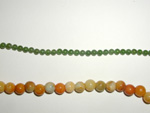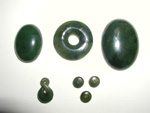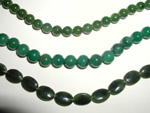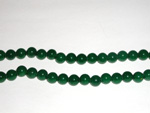
403-5
All About Jade
By: Arbel Shemesh
The Chinese people discovered jade 5,000 years ago; since then, it has
held a very sacred place in their culture. Most Chinese people wear a
Buddha made of jade, given to them by a loved one; it is considered one
of their most precious possessions. Jade is so entwined in the Chinese
culture that it means “beautiful” in the Chinese language;
if you want to say “beautiful mountain” you say “jade
mountain.” The Maoris of New Zealand used jade in place of metal;
their jade weapons and tools actually hold a better edge than iron. Jade
was considered the real treasure of the Maya and Aztec civilizations,
coming before gold and emeralds in value.
Jade has a long history in jewelry. Traditionally, it is worn by itself
or in combination with gold, pearls and diamonds. It is worn for good
luck as well as for adornment.
There are many green gemstones, but there are only two true jades: jadeite
and nephrite. They have different characteristics that help to differentiate
them but there are always exceptions to the rule. Gemologists can tell
them apart by performing tests measuring the reflective index and viewing
the absorption spectra
of the two stones.
Jadeite is usually a brighter green; however, it also comes in lavender,
red-orange yellow, brown, white, black and gray. Imperial jade (jadeite)
is a vivid bright green and can command a price greater than diamonds.
Nephrite is usually a darker green and in some cases has dark spots that
will identify it as nephrite (as they do not appear in jadeite).
Carving in jade is an ancient art in many cultures, and many of the carvings
have special meaning. The Buddha of prosperity, tossing coins above his
head, is carved in many gemstones, but when carved in jade it brings the
most luck and prosperity. You might have heard that jade is a very hard
stone and wondered, if it is so hard, why is it a choice gemstone for
carving? There is a difference between hardness and toughness. Hardness
measures how easily a stone is scratched. The hardest gem is diamond,
10 on the Mohs hardness scale. Jadeite is only 6.5-7 and nephrite is 6-6.5,
which is why jade can be carved. Toughness measures how easily a stone
breaks when struck. Jade earns the highest rating, “exceptional,”
where diamond is exceptional only in certain directions - if struck along
the cleavage plain, it will break. Jade is made up of interlocking crystals
that create a tightly intergrown, compact mass that bonds together and
resists breaking.
When a jade buyer looks at a piece of rough jade at the market, the only
visible sign of the stone’s quality shows through a small window
polished on the stone. The buyer takes a risk on the rest of the rough
stone. The buyer can also wet the rough stone trying to determine the
color, but none of these tests are a sure sign of what lies beneath.
There are a few jade substitutes; these gemstones are beautiful in their own right but should not be confused with true jade.
- Serpentine ranges in toughness between 2.5-6, and is used a lot in
carvings that look very much like jade carvings. You can scratch most
serpentine so it can be used to tell it apart from jade; however, Booyo
precious serpentine can be as tough as nephrite jade so it is the exception
to the rule. Also, be aware that scratching is a destructive test so
use it wisely.
- Chrysoprase chalcedony sometimes achieves the popular “apple
green” color of jadeite, making it a desirable gem.
- Green hydrogrossular garnet is a fairly common jade substitute.
In conclusion, jade is one of the most influential gemstones in human history, helping to shape many cultures from ancient times to the present.
| Project Images | Samples of Jadeite | |||
| Project Images | Samples of Nephrite | ||||||
| Project Images | Samples of Jade look-a-likes | |||









